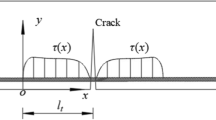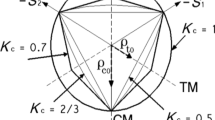Abstract
This paper presents the application of a new steel-concrete bond model on a reinforced concrete shear wall, experimentally tested during the French National Project CEOS.FR. The proposed results include both global (evolution of the force as a function of the displacement for example) and local results (crack opening and spacing). A new post-processing method to compute these local properties even in a case of a complex crack pattern (oriented cracks for example) is proposed. It is based on the change in the sign of the bond slip between steel and concrete. The simulated results are in a good agreement with the experiment and validate the developments. Finally, the interest of including a specific steel-concrete bond model in the finite element simulation is highlighted, compared to classical “no-slip” relation.
Similar content being viewed by others
References
Eurocode 2, Calcul des Structures en béton, NF-EN-1992, 2007.
M.A. Polak, F.J. Vecchio, Nonlinear analysis of reinforced concrete shells, Journal of Structural Engineering 119 (12) (1993) 3439–3462.
A. Hillerborg, M. Modeeer, P.E. Peterson, Analysis of crack formation and crack growth in concrete by means of fracture mechanics and finite elements, Cement and Concrete Research 6 (6) (1976) 773–782.
H.D. Bui, Mécanique de la rupture fragile, Masson, Paris, 1978.
G.I. Barenblatt, The mathematical theory of equilibrium cracks in brittle fracture, Advanced Applied Mechanics 7 (1962) 55–129.
J. Lemaitre, J.L. Chaboche, Aspect phénoménologique de la rupture par endommagement, Journal de Mécanique Appliquée 2 (1978) 317–365.
R. Faria, J. Oliver, M. Cervera, A strain based plastic viscous-damage model for massive concrete structures, International Journal of Solids and Structures 35 (14) (1998) 1533–1558.
L. Jason, A. Huerta, G. Pijaudier-Cabot, S. Ghavamian, An elastic plastic damage formulation for concrete. Application to elementary tests and comparison with an isotropic damage model, Computational Methods in Applied Mechanics and Engineering 195 (52) (2006) 7077–7092.
J. Mazars, Application de la mécanique de l’endommagement au comportement non linéaire et à la rupture du béton de structure, (Ph.D. Thesis), Université Pierre et Marie Curie, 1984.
S. Fichant, C. La Borderie, G. Pijaudier-Cabot, Isotropic and anisotropic descriptions of damage in concrete structures, Mechanics of Cohesive Frictional Materials 4 (1999) 339–359.
L. Jason, A. Torre-Casanova, L. Davenne, X. Pinelli, Cracking behavior of reinforced concrete beams. Experiment and simulations on the numerical influence of the steel concrete bond, International Journal of Fracture 180 (2) (2013) 243–250.
D. Ngo, A.C. Scordelis, Finite element analysis of reinforced concrete beams, ACI Journal 64 (1967) 152–163.
D. Brancherie, A. Ibrahimbegovic, Novel anisotropic continuum-discrete model capable of representing localized failure of massive structures. Part I: Theoretical formulation and numerical implementation, Engineering Computations 26 (2009) 100–127.
N. Domínguez, D. Brancherie, L. Davenne, A. Ibrahimbegovic, Prediction of crack pattern distribution in reinforced concrete by coupling a strong discontinuity model of concrete cracking and a bond slip of reinforcement model, Engineering Computations 22 (2005) 558–582.
N. Domínguez, Etude de la liaison-acier enter l’acier et le béton: de la modélisation du phénomène à la formulation d’un élément enrichi “Béton Armé”, (Ph.D. thesis), Ecole Normale Supérieure de Cachan, 2005.
A. Ibrahimbegovic, A. Boulkertous, L. Davenne, D. Brancherie, Modeling of reinforced concrete structures providing crack spacing based on XFEM, EDFEM and novel operator split solution procedure, International Journal of Numerical Methods in Engineering 83 (2010) 452–481.
A. Casanova, L. Jason, L. Davenne, Bond slip model for the simulation of reinforced concrete structures, Engineering Structures 39 (2012) 66–78.
C. Mang, L. Jason, L. Davenne, A new bond slip model for reinforced concrete structures in monotonic and cyclic loadings, Engineering Computations 32 (7) (2015).
A. Torre-Casanova, L. Jason, L. Davenne, X. Pinelli, Confinement effects on the steel-concrete bond strength and pull-out failure, Engineering Fracture Mechanics 97 (2013) 92–104.
CEOS.FR French National Project, 2015. www.ceosfr.org.
G. Ruocci, D. Chebl, S. Erlicher, P. Bisch, Experimental Investigation and engineering interpretation on shear cracking in RC walls due to cyclic loading, in: Proceeding of SMIRT 2013 Conference, 2013.
B. Belletti, R. Esposito, C. Damoni, Numerical prediction of the response of a squat shear wall subjected to monotonic loading through PARC_CL model, in: Proceeding of the VIII International Conference on Fracture Mechanics of Concrete and Concrete Structures (FraMCoS-8), 2013.
Cast3M, 2015. www.cast3m.cea.fr.
C. Comi, S. Mariani, U. Perego, An extended FE strategy for transition from continuum damage to mode I cohesive crack propagation, International Journal for Numerical and Analytical Methods in Geomechanics 31 (2) (2007) 213–238.
A. Simone, G.N. Wells, L.J. Sluys, From continuous to discontinuous failure in a gradient enhanced continuum damage model, Computer Methods in Applied Mechanics and Engineering 192 (2003) 4581–4607.
J. Mazars, G. Pijaudier-Cabot, From damage to fracture mechanics and conversely: a combined approach, International Journal of Solids and Structures 33 (1996) 3327–3342.
J. Oliver, A.E. Huespe, M.D.G. Pulido, E. Chaves, From continuum mechanics to fracture mechanics: the strong discontinuity approach, Engineering Fracture Mechanics 69 (2002) 113–136.
F. Dufour, G. Pijaudier-Cabot, M. Choinska, A. Huerta, Extraction of a crack opening from a continuous approach using regularized damage models, Computers and Concrete 5 (4) (2008) 375–388.
M. Matallah, C. La Borderie, O. Maurel, A practical method to estimate crack opening in concrete structures, International Journal of Numerical and Analytical Methods in Geomechanics 34 (2010) 1615–1633.
G. Ruocci, C. Rospars, P. Bisch, S. Erlicher, G. Moreau, Cracks distance width in reinforced concrete membranes: experimental results from cyclic loading histories, in: Proceedings of the 15th WCCE Conference, Lisboa, Portugal, 2012.
J. Rethoré, F. Hild, S. Roux, Extended digital image correlation with crack shape optimization, International Journal for Numerical Methods in Engineering 73 (2007) 248–272.
T. Wang, T.C. Hutchinson, Gas leakage rate through reinforced concrete shearwall: numerical study, Nuclear Engineering and Design 235 (2005) 2246–2260.
G. Pijaudier-Cabot, Z.P. Bazant, Nonlocal damage theory, Journal of Engineering Mechanics 113 (1987) 1512–1533.
Author information
Authors and Affiliations
Corresponding author
Rights and permissions
About this article
Cite this article
Mang, C., Jason, L. & Davenne, L. Crack opening estimate in reinforced concrete walls using a steel-concrete bond model. Archiv.Civ.Mech.Eng 16, 422–436 (2016). https://doi.org/10.1016/j.acme.2016.02.001
Received:
Accepted:
Published:
Issue Date:
DOI: https://doi.org/10.1016/j.acme.2016.02.001




